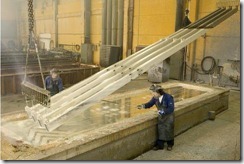Surface Treatment – Ladders, Trays and Baskets

Image Source: Galvano
Steel ladders, trays and baskets form the backbone of cable containment systems. Often these items need some form of surface treatment to prevent corrosion due to the installed environmental conditions. The type of surface treatment required depends on the installed environment and corrosive conditions present.
The standard ISO 12944 defines six categories of corrosive atmospheric environment. The table below lists the classification and gives some.
| Classification |
Examples |
| Cat. |
Corrosion Level |
Exterior |
Interior |
| C1 |
very low |
- |
Heated buildings with clean
atmospheres, e.g. offices, shops, schools, hotels.
|
| C2 |
low |
Atmospheres with low level of pollution. Mostly rural areas. |
Unheated buildings where condensation may occur, e.g. depots, sports halls. |
| C3 |
medium |
Urban and industrial atmospheres, moderate sulphur dioxide pollution. Coastal areas with low salinity. |
Production rooms with high humidity
and some air pollution, e.g. food-processing plants, laundries, breweries, dairies. |
| C4 |
high |
Industrial areas and coastal areas with moderate salinity. |
Chemical plants, swimming pools, coastal ship- and boatyards. |
| C5-I |
very high (industrial) |
Industrial areas with high humidity and aggressive atmosphere. |
Buildings or areas with almost permanent condensation and with high pollution. |
| C5-M |
very high (marine) |
Coastal and offshore areas with high salinity. |
Buildings or areas with almost permanent condensation and with high pollution. |
The table below list common surface coatings typical application areas:
| Surface Coating |
Description |
Application |
Electroplated zinc
Standard EN 12 329
|
Zinc coating of steel by immersion in electrolyte and using electric current. |
Corrosion Class C1
Indoor & normal environments |
Pre-galvanised
Standard BS EN 10327 |
Steel sheets or wires coated by immersion molten zinc, prior to manufacture . |
Corrosion Class C1, C2
Indoor and low corrosion exteriors |
Hot dip galvanised
Standard BS EN ISO 1461 |
Manufactured part immersed in molten zinc. Results in a thick coating |
Corrosion Class C3, C4
Exterior, chemical and marine environments |
Stainless steel
Standard BS EN 10088 |
Naturally offers corrosion protection. |
Corrosion Class C5-I, C5-M
Chemical, marine and food production |
| Thermoplastic coating |
Part coated by melted plastic powder. |
Aggressive environments |
Note: many other specialist (proprietary) coatings exist; zinc-aluminium, polyester zinc etc. These typically would have specialist applications.
Note: Zinc coatings protect parts as both a coating and sacrificial anode. The sacrificial anode enables small scratches to repair themselves. The life of the coating is directly proportional to it's thickness – twice as thick and it will last twice as long